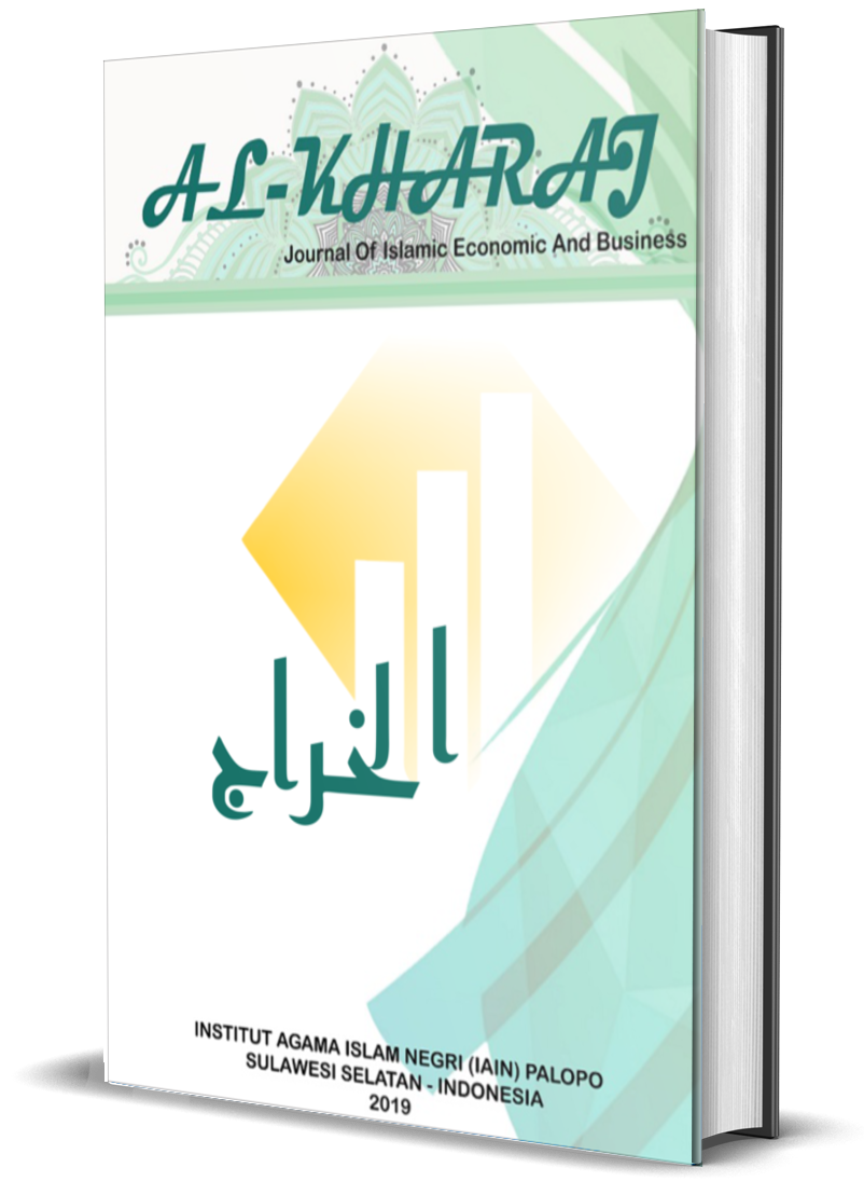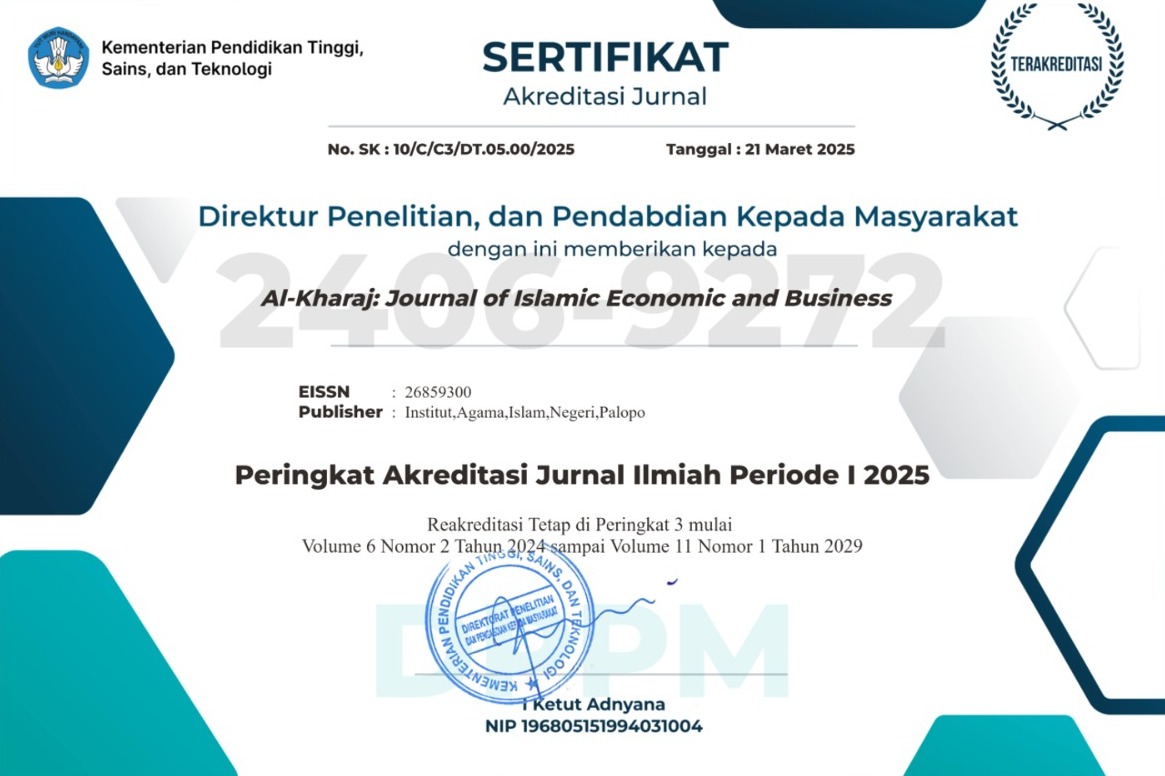Productive Zakat and Poverty Alleviation Through (Cibest Model Approach) at Baznas, Kendari City, Southeast Sulawesi Province
DOI:
https://doi.org/10.24256/kharaj.v7i3.7585Keywords:
Zakat PProductivity, Poverty, and the CIBEST ModelAbstract
Poverty remains a major challenge to economic development in Indonesia, including in Kendari City, Southeast Sulawesi Province. One instrument believed to provide a solution to this problem is zakat, particularly productive zakat. This study aims to analyze the role of productive zakat in poverty alleviation through the CIBEST Model approach at the National Aznas (BAZNAS) in Kendari City, Southeast Sulawesi Province. The CIBEST Model offers a comprehensive approach that measures poverty not only from a material perspective but also from a spiritual perspective.The results of the study indicate that the poverty level and welfare of mustahiq (recipients) in BAZNAS Kendari City experienced significant changes after the implementation of productive zakat. Based on the CIBEST Model approach, there was an increase in material and spiritual welfare among beneficiaries, with the welfare category of Quadrant I increasing from 5 to 8 households. Quadrant II, the material poverty category, decreased from 5 to 2 households. Meanwhile, no households fell into the spiritual and absolute poverty categories after receiving productive zakat. However, the implementation of productive zakat has not been fully effective, with 2 out of 10 informants still classified as poor due to business location and health conditions. Nevertheless, their spiritual aspects showed positive development. BAZNAS needs to strengthen training, mentoring, and business supervision, although limited human resources remain a barrier.
References
Afiyana, IF, Nugroho, L., Fitrijanti, T., & Sukmadilaga, C. (2019). Challenges of Zakat Fund Management in Indonesia and Zakat Literacy. Accountable, 16(2), 222-229. Mulawarman University.
Ardi, N., & Isnayanti. (2020). Structural Equation Modeling-Partial Least Square to Determine the Correlation of Factors Affecting Poverty in Indonesian Provinces. IOP Conference Series: Materials Science and Engineering, 846(1). https://doi.org/10.1088/1757-899X/846/1/012054
Arno, A., & Mujahidin, M. (2024). Enhancing Zakat Management: The Role of Monitoring and Evaluation in the Amil Zakat Agency. Jurnal Economia, 20(3), 397-418. doi:https://doi.org/10.21831/economia.v20i3.53521
Astika, S., Basalamah, S., & Amiruddin, A. (2021). Optimizing Zakat for Poverty Alleviation (A Study at Baznas Makassar City). Ar-Ribh: Journal of Islamic Economics, 4(1), 38–61. https://doi.org/10.26618/jei.v4i1.5213
Azis, A., Fasa, MI, & Suharto. (2022). Productive Zakat Management Strategy in Poverty Alleviation (Case Study of Baznas, Bandar Lampung City). Jurnal Bina Bangsa Ekonomika, Vol. 15, N(01), 151–158.
Beik, IS, & Laily Dwi Arsyianti. (2015). Construction Of CIBEST Model as Measurement Of Poverty And Welfare Indices From Islamic Perspective. Al-Iqtishad Journal, VII(01).
Busyro, W., & Razkia, D. (2020). THE IMPACT OF ZAKAT DISTRIBUTION IN REDUCING POVERTY BASED ON THE CIBEST MODEL (CASE STUDY AT BAZNAS, PEKANBARU CITY). Tabarru' Journal: Islamic Banking and Finance, 3(2).
Daulay, Jaka Ragil, NK and AS (2022). PRODUCTIVE ZAKAT (Review of Islamic Law in the Works of Prof. DR. Yusuf Al-Qardawi). Al-Mashlahah: Journal of Islamic Law and Islamic Social Institutions, 10(02), 1001–1016. https://doi.org/10.30868/am.v10i02.3184
Fiqran, M., Mujahidin, M., Bakri, A. N., & Abdulrahman, A. J. A. (2024). Motivation for Waqf in Millennials and Generation Z: Highlighting Religiosity, Literacy and Accessibility. IKONOMIKA, 9(2), 309-332.
Ilhaniyah, SRM and MKA (2019). FACTORS INFLUENCING THE WELFARE OF MUSTAHIQ IN THE USE OF PRODUCTIVE ZAKAT AT LAZNAS ORGANISATION MANDIRI SURABAYA. 2(2017), 118–128.
Ishak, I., Putri, Q. A. R., & Sarijuddin, P. (2024). Halal Product Assurance at Traditional Markets in Luwu Raya Based on Halal Supply Chain Traceability. Amwaluna: Jurnal Ekonomi dan Keuangan Syariah, 8(2), 224-240.
K, A. ., Astuti, A. R. T. ., & ., Mujahidin. (2024). The Impact of Word of Mouth and Customer Satisfaction on Purchase Decisions: The Role of Maslahah as an Intervening Variable in the Cosmetic Products Industry in Indonesia. Journal of Ecohumanism, 3(7), 1525–1540. https://doi.org/10.62754/joe.v3i7.4307
Lestari, RSD, & Alwi, MA (2022). Productive Zakat as an Instrument for Poverty Alleviation for the Productive Age Community. MALIA: Journal of Islamic Economics, 14(1), 37–50. https://doi.org/10.35891/ml.v14i1.3679
Mahendra, Y., Kara, M., & Bulutoding, L. (2022). Poverty Typology Using the Cibest Quadrant Model (Case Study in Belawa District). At Tawazun Journal of Islamic Economics, 1(3), 92–108. https://doi.org/10.24252/attawazun.v1i3.25839
Majid, N. H. A., Omar, A. M., & Busry, L. H., Mujahidin Reviving Waqf In Higher Education Institutions: A Comparative Review Of Selected Countries. European Proceedings of Social and Behavioural Sciences.
Mujahidin, M., Imran, M., Sapa, N. B., Fasiha, F., Aisya, S., & Trimulato, T. (2025). Challenge of Waqf to the Social and Economic Welfare of Muslim Communities: A Comparative Analysis Between Countries. Jurnal Ilmiah Mizani: Wacana Hukum, Ekonomi Dan Keagamaan, 12(1), 168-184.
Mujahidin, Rahmadani, N., & Putri, Q. A. R. (2024). Analysis of the Influence of Religiosity Values In Reducing Consumptive Behavior in Indonesian Muslim Consumers. Amwaluna: Jurnal Ekonomi dan Keuangan Syariah, 8(2), 253-274.
Nurjati, E. (2021). The Socioeconomic Determinants of Poverty Dynamics in Indonesia. MIMBAR: Journal of Social and Development Studies, 37(2), 345–354. https://doi.org/10.29313/mimbar.v37i2.8024
Prasada, Y. et al. (2020). Determinants of poverty rate in Java Island: Poverty alleviation policy. Journal of Development Economics, 18(2), 95–104. https://doi.org/10.29259/jep.v18i2.11664
Putri, Q. A. R., Fasiha, F., & Rasbi, M. (2024). Affiliate marketing and intention to adopt mudarabah: The mediating role of trust in Islamic financial decision-making. JEMA: Jurnal Ilmiah Bidang Akuntansi Dan Manajemen, 21(2), 337–362. https://doi.org/10.31106/jema.v21i2.23381
Reza Dasangga, DG, & Cahyono, EF (2020). Analysis of the Role of Zakat in Poverty Alleviation Using the Cibest Model (Case Study of Rumah Gemilang Indonesia, Surabaya Campus). Journal of Theoretical and Applied Islamic Economics, 7(6), 1060. https://doi.org/10.20473/vol7iss20206pp1060-1073
Sapsuha, M. U., Alwi, Z., Sakka, A. R., & Al-Ayyubi, M. S. (2024). Review of Gold Trading Practices on Credit (non-Cash) Based on Hadith. Al-Kharaj: Journal of Islamic Economic and Business, 6(3).
Sudipa, N., & Nurjani, PS (2021). Strategy for Accelerating Poverty Reduction in Klungkung Regency, Bali. Jurnal Bina Praja, 13, 41–51. https://doi.org/10.21787/jbp.13.2021.41-51
Syauqi Beik, I., & Arsyianti, LD (2016). MEASURING ZAKAT IMPACT ON POVERTY AND WELFARE USING CIBEST MODEL. In Journal of Islamic Monetary Economics and Finance (Vol. 1, Issue 2).
The Influence of Brand Equity and Service Quality on the Decision to Use Islamic Banking Services. (2024). International Journal of Religion, 5(11), 7402– 7409. https://doi.org/10.61707/gfqm3b30
Wulandari, S., Irfan, A., Zakaria, N. B., & Mujahidin. (2024). Survey Study on Fraud Prevention Disclosure Measurement at State Islamic Universities in Indonesia. IQTISHODUNA: Jurnal Ekonomi Islam, 13(1), 327–348. https://doi.org/10.54471/iqtishoduna.v13i1.2305
Downloads
Published
How to Cite
Issue
Section
Citation Check
License
Copyright (c) 2025 Rahmah Rafifah Abu, Abdul Wahab, Idris Parakkasi

This work is licensed under a Creative Commons Attribution-ShareAlike 4.0 International License.
Authors retain copyright and grant the journal right of first publication with the work simultaneously licensed under a Creative Commons Attribution-ShareAlike 4.0 International License. In line with the license, authors are allowed to share and adapt the material. In addition, the material must be given appropriate credit, provided with a link to the license, and indicated if changes were made. If authors remix, transform or build upon the material, authors must distribute their contributions under the same license as the original.









